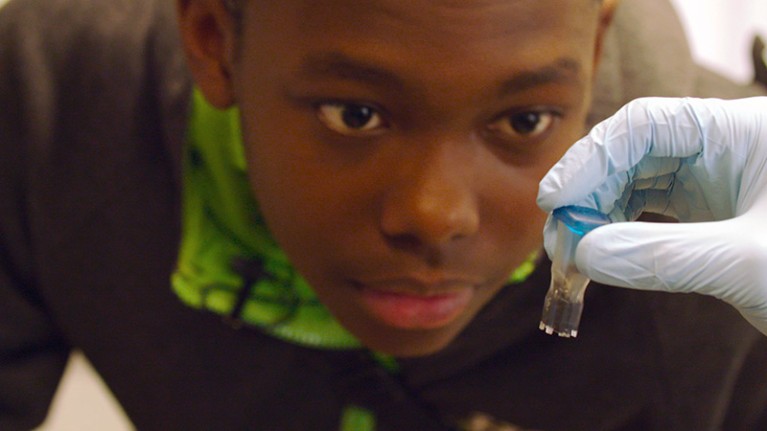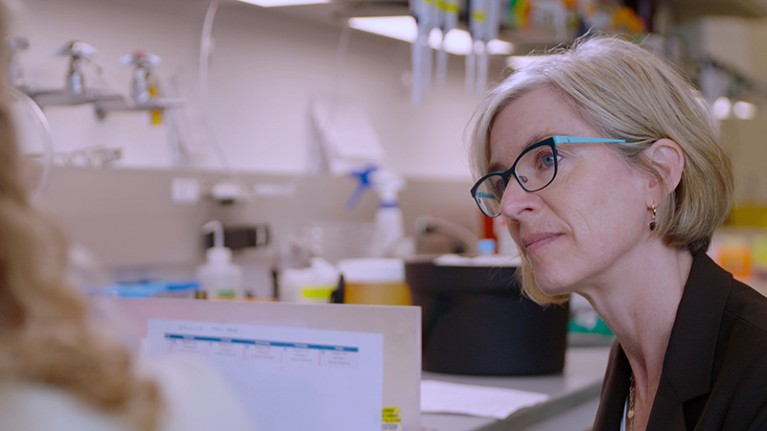
David Sanchez appears in the documentary: he has sickle-cell anaemia, which could one day be addressed using gene editing.Credit: Wonder Collaborative
At the start of Human Nature, a documentary about the gene-editing tool CRISPR, we meet a young man with sickle-cell anaemia. David Sanchez is wise beyond his years, driving home the injustice of his gruelling blood infusions and shortened lifespan. Researchers are testing a therapy for his condition in clinical trials using CRISPR.
This is a film probing the unknown future of a technology that, within the past decade, has skyrocketed from obscurity to become the subject of a Netflix series called Unnatural Selection that debuted on 18 October (the trailer promises provocation by leading with biohackers injecting the editing tool). Human Nature does not take a shock–horror approach. This is the film that scientists would probably prefer the public to see.
The project began with a meeting between the Wonder Collaborative, a scientific documentary organization based in San Francisco, California, and CRISPR co-discoverer Jennifer Doudna, a biochemist at the University of California, Berkeley (UC Berkeley), and her colleagues. The scientists guided the film-makers, led by a team of co-producers (including former cell biologist Sarah Goodwin and journalists Dan Rather and Elliot Kirschner) and director Adam Bolt, on the scientific and ethical issues. And the film-makers read up on the technology themselves. When the film was nearly complete, they sought feedback from members of the National Academies of Science, Engineering and Medicine.
As a result, the film is high on the thrill and potential of discovery, and every scientist and bioethicist featured is passionate and thoughtful. Notably, the documentary sidesteps academic politics, such as the ongoing patent battle over who will reap CRISPR’s financial rewards. And it lacks input from scientists outside the United States and western Europe — such as from China, where the first human embryos have been edited — or from policymakers with the power to restrict what research is permissible. However, it does feature a handful of people who have genetic disorders as well as parents of children with these maladies.

Jennifer Doudna, one of the CRISPR pioneers central to the film.Credit: Wonder Collaborative
Human Nature follows a straight path, beginning with the seeds of genetic engineering in the 1960s and ending in the ethical quagmires of making changes to human DNA that future generations could inherit. The film will be educational for people who haven’t heard of CRISPR before; little will be new for those who have. Having covered the story from the beginning, I enjoyed watching the who’s who of CRISPR’s early years speak for themselves.
And the technology itself is covered beautifully. The camera swoops over crystalline salt pools in Spain, where Francisco Mojica, a microbiologist at the University of Alicante, ponders the repeated genetic letters in bacterial genomes — and the ‘spacers’ of unidentified DNA sequences in between. In 2005, he revealed that the enigmatic spacers mimic genes from viruses that once infected the microbes, and that these sequences form a kind of ‘memory’ that allows bacteria to recognize and attack the invaders in future. Animations of double helices clarify what happens; they reappear when Doudna’s team adapts CRISPR as a laboratory workhorse. Even this scene has a pulse, due to the ever-enthusiastic Fyodor Urnov, science director at the Innovative Genomics Institute, UC Berkeley’s centre focused on CRISPR. Together with the enzyme Cas9, CRISPR spots and snips genes that it’s been programmed to find.
Feng Zhang at the Broad Institute of MIT and Harvard in Cambridge, Massachusetts, appears briefly. But scant attention is devoted to his groundbreaking studies from 2013 enabling CRISPR to edit animal DNA (these are the experiments at the centre of the Broad’s contested patents). And although a montage of headlines shows a subsequent flurry of experiments in which scientists edit various organisms, little is said about how these studies have pushed forwards fields ranging from evolutionary biology to agriculture. Nor do we learn about scientists’ continuing struggle to insert genes using CRISPR in most organisms other than mice and flies. Their attempts often fail, or result in side effects or death.
The film-makers probably feared that audiences would weary of details. But I was hungry for an update on what scientists are actually doing right now. That’s especially true when it comes to editing people. But rather than dwell on a couple of dozen CRISPR-based therapies in early stages of testing, the film bounds into the possibilities of engineering humans using CRISPR with an ominous clip of Russian president Vladimir Putin speaking in 2017. Soldiers, he says, could be endowed with the ability to fight without pain. And Urnov explains how: CRISPR could be used to delete a gene that transmits pain signals to the brain. He says he’s sure that this will become an analgesic treatment offered to cancer patients in pain.
The rest of the film centres on the ethics of human editing, as if everything were possible. George Daley, a stem-cell biologist at Harvard Medical School in Boston, Massachusetts, draws a line between editing embryos and editing adults; in the former case, children would be born with the alteration in all their cells and changes would be passed down through generations. All the scientists (the protagonists of this film) are conscientious. Doudna, for example, says that Hitler showed up in one of the nightmares she had that were triggered by her anxiety over the potential misuse of the tool. In 2015, Urnov and his colleagues argued that editing embryos, sperm and eggs should be banned for now1. And earlier this year, Zhang and others recommended that scientists come up with a framework that governments could use to evaluate research proposals as the science of gene editing progresses2.
Still, other scientists can’t contain their excitement. Stephen Hsu, a co-founder of Genomic Prediction, a genetic testing company for in vitro fertilization in North Brunswick, New Jersey, suggests that, eventually, editing could advance humanity by making people healthier, longer-lived or smarter. The documentary pushes him on this point, and flashes a Nazi propaganda clip. Hsu counters that his vision is different from eugenics because the choice to edit is made by parents.
Alta Charo, a bioethicist at the University of Wisconsin–Madison, also dismisses certain fears, pointing out, for example, that characteristics such as intelligence are controlled by multiple genes and by the environment. But she concedes that there is a risk to editing, and therefore it shouldn’t be used frivolously. Just 30 out of 195 countries have banned the editing of human embryos, sperm and eggs in the clinic with CRISPR, and the rules might not govern pure research.
Human Nature traces CRISPR up to a pivotal moment. The film was nearly finished when the news was reported last November that twin girls had been born after Chinese biophysicist He Jiankui had used CRISPR to edit their embryos. So the film-makers just spliced it in as an afterthought. After the heroes of the film had spent so much time expounding on the need to prevent this outcome, its sudden fruition is troubling. Asked why the film-makers didn’t revise the documentary to focus on the case, Kirschner says that they decided there was value in what they had: a film on CRISPR’s origins. Plus, we truly don’t know what will happen next. Kirschner writes: “It is impossible to tell whether it will ultimately be seen as an inflection point or an aberration.”
The Wonder Collaborative had considered creating just a brief CRISPR explainer. I’m glad they opted for a full-length feature: it gives them time to strike a nerve. For me, this happened in the scenes with Sanchez. At the end of the film, after so many researchers have gushed about the power of CRISPR to cure disease, the interviewer asks Sanchez if he wished his parents had used the tool to prevent his being born with a deadly condition. Sanchez pauses, and says no: “I don’t think I’d be me.”




